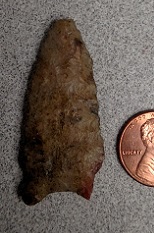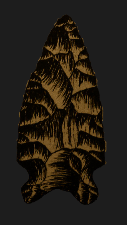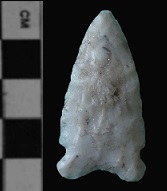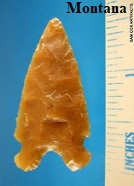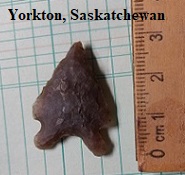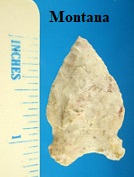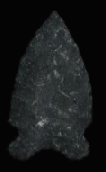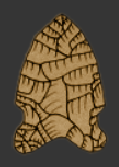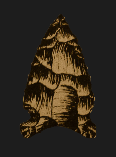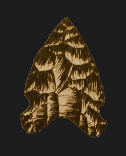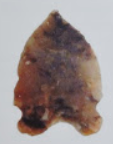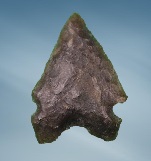Other Websites with Detailed Information:
Name Details:
Named By: Robert W. Nero and Bruce McCorquodale
Named For: Type Site
Date Identified: 1958
Type Site: Oxbow Dam Site, Saskatchewan,
Canada
Oxbow
AKA: Parkdale (Minnesota)
Cluster: Oxbow Cluster
Commonly Utilized Material:
Various local materials commonly heat treated.
Avon Chert
Date:
Cultural Period:
4,700 to 3,000 B.P.
Middle to Late Archaic
Middle Holocene
Oxbow Culture
Glacial Period:
Culture:
Outline is Representative of Size and Shape:
Description of Physical Characteristics and Flaking Pattern:
This is a
small to medium triangular side notched point. The cross section may vary from flattened to elliptical. The blade
varies from excurvate to almost straight. Parallel notches are commonly shallow and maybe very slight indentions on some examples.
The shallow notches forms a wide neck. The shoulders are commonly sloping upwards and may be weak. The stem is
short and expanding
with a base that is is deeply concaved
to bifurcate and rounded basal auricles or ears. Basal
thinning and grinding is commonly present along with slight grinding
seen in the notches. This point has a random flaking pattern.
Size Measurements: Total Length - 28 to
84 mm (average 40 to 50 mm), Stem Length - 8 to 13 mm, Blade
Width - 16 to 28 mm, Neck Width - 13 to 22 mm, Stem Width -
14 to 26 mm, Basal Concavity - 3 to 7 mm
Distribution:
Distribution Comments:
The Oxbow culture
was primarily located in the Saskatchewan River Valley and into the
plains of Saskatchewan. With less frequency, this culture extended
into the plains of northwestern Nebraska and eastern Colorado. The
red represent the known territorial area of the Oxbow culture.
Points have been reported into the yellow section, but this extends past
the known territorial area of the Oxbow culture.
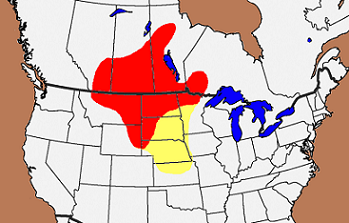
Similar Points:
Avonlea, High River, Irvine, Little Sioux, Nanton, Paskapoo, Swift Current, Tama, Tompkins, Turin, Yonkee Additional Comments:
These points have been referred to as Parkdale Eared points in Minnesota (Caine, 1974). Wettlaufer and Mayer-Oakes (1960) excavated the Long Creek site upstream of the Oxbow Dam site and found similar points from the Oxbow
Phase which they called Long Creek points.
There are many similar types with many of them considered the same type or
at least a continuum of the same type. The Turin point is often
combined with the Simonsen in literature, but differs in that the notch
enters from the corners rather than the side. Morrow (1984) points out
that the Simonsen is the same point as the Little Sioux point from Iowa.
Others note that the Simonsen is the same point as the Long Creek point from
Saskatchewan. It should be noted that many consider the Long Creek
point the same as the Oxbow point. When comparing the accepted dates
for these type, it may be that the Turin point (Early Archaic) was followed
by the Simonsen / Little Sioux (Early to Middle Archaic), which led into the
Long Creek / Oxbow (Middle Archaic).
Other points in this Cluster:
Point Validity: Valid Type
Nero is an avocational archeologist who wrote many books regarding the archaeology of
Saskatchewan. McCorquodale is a respected
paleontologist and did extensive work on the plains and Canadian archeology. This point was named in a professional publication and has many professional references. This is a valid type.
.
Age Details:
Pictures Provided By:
As Illustrated by Perino, 1971
Kim Lonsdale
Paulette Senner
Scott Hillesheim
Western Artifacts
References: (See Reference Page, Entry Number):
23, 30, 176, 180, W2
Oxbow Projectile Point, Oxbow Arrowhead
Parkdale Projectile Point, Parkdale Arrowhead

